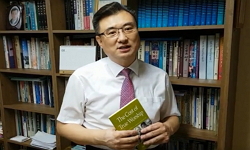It is time to rethink Korean missionary movement as the mission-oriented American church did in 1932 with the publication of Re-Thinking Mission: A Laymen``s Inquiry after One Hundred Years. It is time to reflect upon the real challenges and problems ...
http://chineseinput.net/에서 pinyin(병음)방식으로 중국어를 변환할 수 있습니다.
변환된 중국어를 복사하여 사용하시면 됩니다.
- 中文 을 입력하시려면 zhongwen을 입력하시고 space를누르시면됩니다.
- 北京 을 입력하시려면 beijing을 입력하시고 space를 누르시면 됩니다.

특 집 : 한국 기독교, 어디로 갈 것인가? ; 한국교회의 해외선교, 어디로 갈 것인가? = Rethinking Korean Mission: Searching for a New Direction
한글로보기https://www.riss.kr/link?id=A101803801
- 저자
- 발행기관
- 학술지명
- 권호사항
-
발행연도
2007
-
작성언어
Korean
- 주제어
-
등재정보
KCI등재
-
자료형태
학술저널
-
수록면
30-47(18쪽)
- 제공처
-
0
상세조회 -
0
다운로드
부가정보
다국어 초록 (Multilingual Abstract)
It is time to rethink Korean missionary movement as the mission-oriented American church did in 1932 with the publication of Re-Thinking Mission: A Laymen``s Inquiry after One Hundred Years. It is time to reflect upon the real challenges and problems of mission fields, withholding some celebrating mode do becoming “the second largest missionary-sending country.” The martyrdom of two short-term missionaries in Afghanistan, who had been sent by Sam-Mul Church in 2007 has been a wake-up call for all Korean Christians indeed. It is time for a serious examination and self-evaluation in order to find a new direction. The present author tackles the issues of Korean missionary movement with regard to historical arrangement of the missionary movement, which started in 1907 when the first Korean independent presbytery was organized and the first Korean native pastors were ordained. From the mission of Quelpart to the first cross-cultural mission to Shandung, China, the Korean church has been enthusiastical to foreign mission. The author, however, argues that the contemporary lay-oriented and volunteering missionary movement was initiated in 1989 when the Korean government first abolished the long- standing visa and passport laws to allow free travel to foreign countries for the first time. The author introduces the sociology of mission to understand the early dynamics of Korean missionary movement. He suggests that there are push factors and pull factors to make Korean young missionaries go abroad and to accept Korean missionaries in mission fields. The self-consciousness of the missionary calling and renewed self image of the chosen country as the light of the world have been push factors; the financial ability and the success models in both economical and spiritual welfare would be pull factors. Finally, the author presents three possible ways of searching a new direction of the Korean missionary movement. First, the Korean church should develop her own mission theology and the first candidate would be the translatability of the Gospel. Second, the Korean missionary movement should be executed at global context considering the reality of globalization. Third, the Korean missionaries should not pursue the mere conversion of non-Christians in their mission fields. Rather, the author suggests, the mission of servanthood and living together as a new method of Korean missionary movement.
동일학술지(권/호) 다른 논문
-
- 한국대학선교학회
- 전요섭
- 2007
- KCI등재
-
- 한국대학선교학회
- 김광률
- 2007
- KCI등재
-
- 한국대학선교학회
- 정용석
- 2007
- KCI등재
-
- 한국대학선교학회
- 한일철, 박명철, 박정세, 조재국, 정종훈, 이대성
- 2007
- KCI등재




 KISS
KISS


